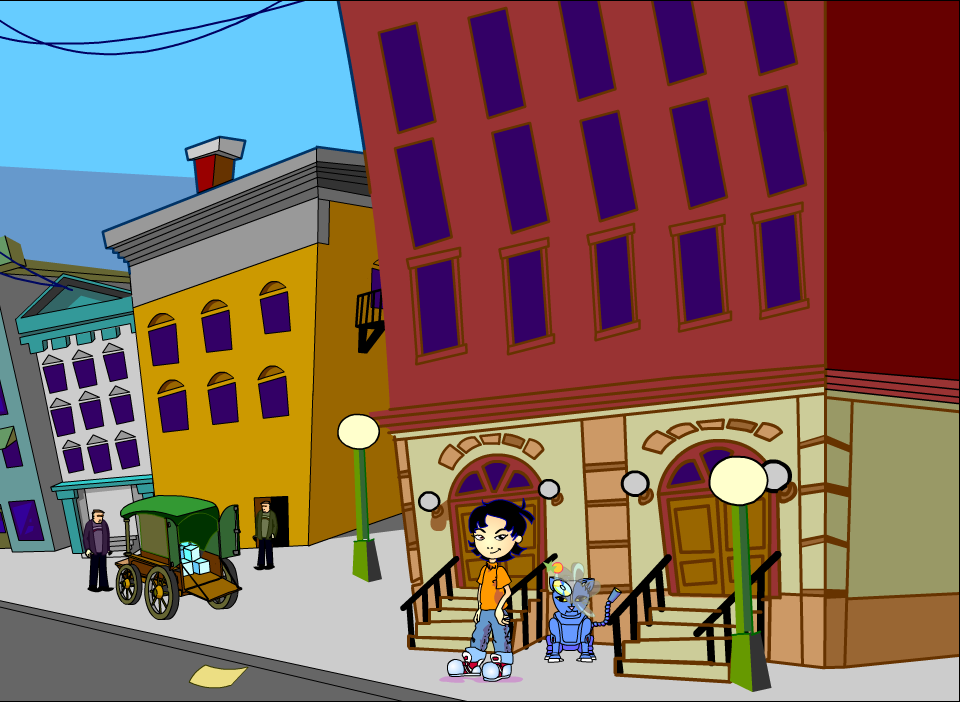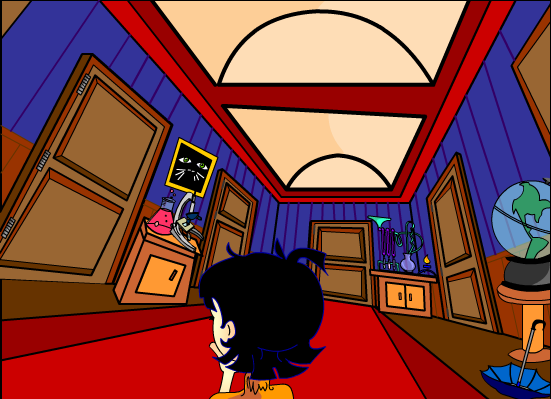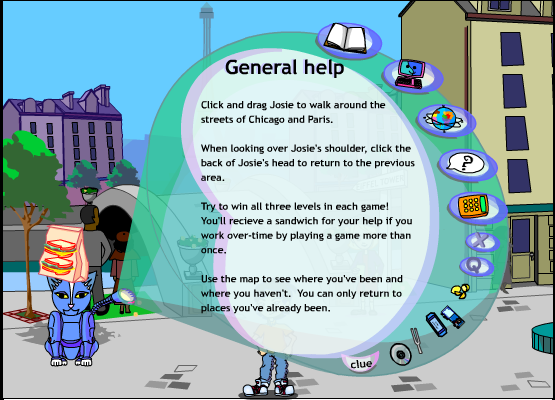Introduction
The Adventures of Josie True is a point and click adventure game designed to get young girls interested in STEM fields. You follow the main character Josie True as she travels through space and time trying to find her lost inventor-turned-teacher Ms. Trombone.
Below is a detailed analysis of this game roughly following Brian Winn's1 Design/Play/Experience framework, including:
Learning
The Adventures of Josie True sets out to
- Change the beliefs and attitudes of young girls
- Spark interest in STEM fields (Science, Technology, Engineering, and Math)
- Provide an alternative to other games that may not have been targeted towards young girls or non-white ethnic groups.
It provides a role-model who is smart, brave and independent, and encourages people from minority groups to:
- Break away from harmful stereotypes
- Follow their interests
- Embrace subjects not typically associated with their race or gender
Storytelling
The game begins in a nondescript modern-day American suburb, but most of it takes place in 1920s Chicago and Paris. The story begins with Josie receiving a notice that their class field trip was cancelled due to the disappeared of her teacher, Ms. Trombone.
Josie goes to her teacher's house to investigate the disappearance. Along the way she encounters math and science based obstacles (such as the keypad to enter the building), which are explained by the fact that Ms. Trombone is an eccentric inventor. Josie ends up travelling through space and time to go to Chicago, where she discovers thieves stealing a mummy and tries to stop them. From there, things only get wilder. The story is pretty much linear, with limited options for interactivity and back-tracking.

The story helps to support the intended learning by showing all of Ms. Trombone's cool inventions, and by bringing history alive in front of the player. It gives the player not one, not two, but three role models -- Bessie Coleman, Ms. Trombone, Josie herself. All three of them are smart and resourceful, and show kids something they might not have had the chance to see before: a smart woman in a science-based field, a woman supporting herself and pursuing her trying, and a girl solving problems with nothing but her wits.
Gameplay
The basic game consists of Josie True exploring the area to find clues and solving various problems, completing puzzles and overcoming challenges based in the areas of math, science, history, and technology to progress forward in the story. For example, the first puzzle that the player has to solve is a simple math puzzle with a couple options, such as: "What is the square root of 9 minus 3?" or "What is the number of the month of December minus the number of the month of July?" from an electronic lock in order to enter Ms. Trombone's home.

After the first puzzle, the game allows selecting three different levels of difficulty for the majority of puzzles. If the player has too much difficulty in solving the puzzle, there is also a "WIN" button provided that the player can press to instantly beat the challenge, since the challenge must be beat in order to progress with the story. The player is also able to "work over-time" by repeating challenges in order to earn sandwiches for a bonus.
All the problems in the game were designed with the intent to spark interest in their respective topics so that the player will later want to learn more about them, and ideally continue to study and explore on their own.
After the player is transported to Chicago, the game changes slightly. Upon completing each challenge Josie True begins to write entries in a journal kept in the iCat (Intellicat) companion, invented by Ms. Trombone, describing her experiences while adventuring in the past.

The iCat can also be clicked on as a type of "main menu" or toolkit that allows the player to see all their rewards so far, a map which allows the player to revisit previous areas, a database of terms, and a calculator.
User Experience
The user interface can be frustrating at times since the objects that you can click on to use to explore are not always immediately obvious. For example, when exploring the city of Chicago in the 1920s, it wasn't immediately obvious that you could click and drag on Josie in order to get her to move around. Interactable items are not highlighted or indicated in any way until you move the mouse over them, so upon entering a new area you often spend the first few moments waving the mouse around trying to figure out what you can and cannot click on. Puzzles can be completed by inputting numbers, clicking on the correct objects, clicking and dragging objects into place, and other such simple tasks.

The iCat main menu also appears very small and hard to navigate. This is likely due to the drastic increase of the computer screen resolution since the game was released, and is most likely not the fault of the game designers or programmers themselves.
Technology
The game was written, drawn, and animated in Flash 4. We agree with the decision to make the game web-based, since that delivery format makes it the most accessible to everyone: all that is required is a computer with Flash Player and a web browser. The only drawback is that with today's large amount of mobile devices not supporting the Flash plugin, the game is not suited for tablets or smartphones, which seem to be one of the most prevalent devices for quick and easy gaming among children and young teens.
Assessment
There doesn't appear to be an existing assessment to determine if the game has met its goals, outside of a statement on the "News" section that 500 people downloaded the teacher's guide per month. One of the ways that the game could assess to see if it was successful would be to use various web analytics tools to determine how much traffic the game received. This would measure if the game was able to reach a wide audience albeit it wouldn't help to determine if it reached the target audience.
Another method of assessing the success of the game would be to do a quick pre-survey asking the age and gender of the player before they begin to play. This would measure to see if the game was able to be played by the target audience.
In order to assess any increased interest in fields, a pre-survey and post-survey would be the best type of assessment in order to attempt to measure interest in the fields of math, science, technology and history. The ideal option would be a test to see if there was an increase in the number of women or racial minorities who applied to tech schools or got jobs in STEM fields, but given the complexity of the problem and the large timescale at hand, such a study would be difficult if not impossible to carry out accurately.
Conclusion
We believe that the The Adventures of Josie True has somewhat met its goals, despite its interface problems and the existence of a "shortcut" to beat the challenges and gameplay elements. It was a well created game with a fair amount of depth that would have stood out among the time of release, considering the competition for online games target towards girls were Barbie games.
Questions
- What did you think of the interface?
- Do you feel that the characters presented are good role models?
- Do you think the challenges would interest people in STEM fields?
- What do you think about the presence of a Win button?
References
- Winn, Brian. The Design, Play and Experience Framework. In R. Ferdig (Ed.), Handbook of Research on Effective Electronic Gaming in Education. Hershey, PA: IGI Global, 2009, pp. 388-401.
- Donovan, Patricia. “The Adventures Of Josie True” Will Take Girls Online Into A Colorful, Multiethnic Educational Playground - http://www.buffalo.edu/news/releases/2000/01/4557.html